北羅納德賽綿羊
 | |
| 保護狀態 | |
|---|---|
| 原產地 | 蘇格蘭 |
| 應用 | 其的肉和羊毛可供人類利用 |
| 綿羊 Ovis aries | |
北羅納德賽綿羊是來自蘇格蘭北部海岸北羅納德賽的綿羊品種,屬於北歐短尾羊品種群。體型通常比大多數品種的羊小,其中公羊大多有角,母羊則大多沒有角。另外,北羅納德賽綿羊以前主要用於羊毛。[3][4][5][6]而現在最大的兩個野生綿羊群,一個在北羅納德賽,另一個在奧克尼群島中的奧斯凱里島。[7][8][9]
相關動保機構珍稀品種保護信託(RBST)將北羅納德賽綿羊列為機構2021-2022年觀察名單上的優先事項,因其有滅絕的風險。而目前在英國,經申報後統計出的可繁殖雌性北羅納德賽綿羊已不到600隻。[10][11]
歷史
[編輯]起源
[編輯]北羅納德賽綿羊是北歐短尾羊的後代。但它們到達北羅納德賽的確切時間尚不清楚,不過可能早於鐵器時代,[12]同時為最早到達英國的綿羊。由於與世隔絕的位置,北羅納德賽綿羊在沒有太多來自於羅馬或歐洲綿羊品種的雜交情況下演化而來,[13][14]但牠們之間仍具有一些共同的特徵,如顏色所在範圍和短尾巴。[15]
進一步的DNA研究則將北羅納德賽綿羊的骨頭與在公元前3000年左右斯卡拉布雷遺址發現的北歐短尾羊遺骸進行了比較,結果顯示出非常接近的匹配,這表明了北羅納德賽綿羊很可能沒有與其他品種在基因上混合。[16]
羊場
[編輯]1839年,北羅納德賽島上成立了北羅納德賽羊場。由11位指定島民組成的小組負責維護城牆、羊群的健康以及記錄羊的所有權。[17][18]而到了今天,羊場原設有的綿羊法庭仍然是負責組織綿羊所有權的監管機構。
現今的物種保護
[編輯]相關組織珍稀品種保護信託(RBST)將北羅納德賽綿羊列為「易危」。[19]
另外,北羅納德賽信託基金和奧克尼綿羊基金會,每年會舉辦一次綿羊節(SheepFest),邀請志願者到島上進行為期兩周的羊堤重建。
特徵
[編輯]
身體
[編輯]北羅納德賽綿羊生長緩慢,體型較一般綿羊小,能夠適應嚴酷、寒冷的環境。公羊通常重約30公斤(66磅),母羊很則少超過25公斤(55磅)[7],正常個體經屠宰去除不能食用的部分後,約只剩13.6公斤(30英磅)。[20]
北羅納德賽羊是原始歐洲短尾羊品種的後代。正如歐洲短尾羊的名字所暗示那樣,北羅納德賽羊天生就有短尾巴。而它們的骨頭比其他品種細,且頭是圓的(向內傾斜)。[7]通常公的北羅納德賽綿羊都具有角,呈脊狀或螺旋狀[21],而母羊則只有20%的有角。[22]
飲食
[編輯]
北羅納德賽綿羊的飲食與一般綿羊有很大的差異,通常以海藻為主食,除了原產於科隆群島的海鬣蜥外,北羅納德賽綿羊是唯一已知有這種飲食習慣的陸生動物,[23][24]科學家推測可能是因為其被1.8米(5.9英尺)高且完全環繞島嶼的乾砌石牆限制活動範圍在了海灘,迫使其進化出以巨藻為食的不尋常特徵。(蓋石牆的目的是將羊群限制在岸邊以保護裡面的田地和小農場)。而這一現象也導致了人們認為海帶可能可用作其他牲畜的替代食物來源。[25] 由於北羅納德賽綿羊不同於其他綿羊的飲食,科學家們推測出其的生理機能與其他綿羊有所不同:北羅納德賽綿羊的消化系統已經適應更有效地提取海藻中的糖分。[26][27][28]
這種飲食習慣使得北羅納德賽綿羊必須比其他品種的綿羊更有效地提取微量元素銅,因為它們飲食中銅的供應有限。 但如果直接餵草給北羅納德賽綿羊食用,其很容易受到銅毒性的影響,因大量的銅對綿羊有毒。放牧習慣也發生了變化,以適應綿羊的環境。另外,為了減少被來潮擱淺的機會,北羅納德賽綿羊會在退潮時吃草,然後在漲潮時反芻。[29][22][30]
利用
[編輯]肉
[編輯]北羅納德賽綿羊的肉具有獨特而濃郁的味道,被描述為「強烈且幾乎是野味」[31][32],並且比大多數的羊肉顏色更深,原因可能是因為北羅納德賽綿羊富含了碘。[32]
羊毛
[編輯]北羅納德賽綿羊的羊毛顏色,包括了灰色、棕色和紅色。[32]其底毛柔軟可做為適合與皮膚接觸的服裝,長毛則因可以保護綿羊免受自然環境寒冷潮濕的天氣影響,纖維十分耐用,往往可用於製做大衣。[33]
參考
[編輯]- ^ Barbara Rischkowsky, D. Pilling (eds.)(2007). p. 138. List of breeds documented in the Global Databank for Animal Genetic Resources, annex to The State of the World's Animal Genetic Resources for Food and Agriculture. Rome:Food and Agriculture Organization of the United Nations. ISBN 9789251057629. Accessed August 2017.
- ^ Watchlist 2017–18. Stoneleigh Park, Warwickshire: Rare Breeds Survival Trust. [30 April 2022]. (原始內容存檔於2021-12-12).
- ^ Hall, "Some recent observations". : 59.
- ^ Elewes, Henry. Guide To The Primitive Breeds Of Sheep And Their Crosses On Exhibition At The Royal Agricultural Society's Show, Bristol 1913. Read Books. 2016 [2022-07-29]. ISBN 9781473352018. (原始內容存檔於2022-07-29).
- ^ Ekarius and Robson, Fleece & Fiber Sourcebook. : 176.
- ^ Ekarius, Carol; Robson, Deborah. The Field Guide to Fleece: 100 Sheep Breeds & How to Use Their Fibers. Storey Publishing. 2013: 147 [2022-07-29]. ISBN 978-1603429269. (原始內容存檔於2022-07-29).
- ^ 7.0 7.1 7.2 Alderson, "Sheep", p. 873.
- ^ Morris, June. The Case for Exempting Primitive Sheep from the National Scrapie Plan. Soay Farms. September 2000 [4 January 2016]. (原始內容存檔於2022-03-31).
- ^ Townsend, S. J.; Warner, R.; Dawson, M. PrP genotypes of rare breeds of sheep in Great Britain. Veterinary Record. 2005, 156 (5): 131–34 [2022-07-29]. PMID 15715003. S2CID 43625862. doi:10.1136/vr.156.5.131. (原始內容存檔於2018-11-06).
- ^ RBST與北羅納德賽綿羊. RBST. [2022-08-07]. (原始內容存檔於2022-08-07).
- ^ 英國的相關報告. Flood Street Farm. [2022-08-07]. (原始內容存檔於2022-08-07).
- ^ Long, John L. Introduced Mammals of the World: Their History, Distribution and Influence. CSIRO Publishing. 2003: 527 [2022-07-29]. ISBN 9780643099166. (原始內容存檔於2021-12-01).
- ^ Alderson, Lawrence. Mason's World Encyclopedia of Livestock Breeds and Breeding, 2 Volume Pack. CAB International. 2016: 872–74. ISBN 9781845934668.
- ^ Vorwald Dohner, Janet. The Encyclopedia of Historic and Endangered Livestock and Poultry Breeds. Yale University Press. 2001: 96–98 [2022-07-29]. ISBN 9780300138139. (原始內容存檔於2022-05-09).
- ^ Ryder, M. L. A survey of European primitive breeds of sheep. Annales de Génétique et de Sélection Animale. 1981, 13 (4): 381–418 [1978]. PMC 2718014
 . PMID 22896215. doi:10.1186/1297-9686-13-4-381.
. PMID 22896215. doi:10.1186/1297-9686-13-4-381.
- ^ Blacker, Susan. Pure Wool: A Guide to Using Single-Breed Yarns. Stackpole Books. 2012 [2022-07-29]. ISBN 9780811760959. (原始內容存檔於2022-03-28).
- ^ Black, Land That Thyme Forgot, p. 155.
- ^ Archer, Mark; Grantham, Mark; Howlett, Peter; Stansfield, Steven. Bird Observatories of the British Isles. Bloomsbury Publishing. 2010 [2022-07-29]. ISBN 9781408139066. (原始內容存檔於2022-04-16).
- ^ Watchlist 2014. The Ark (Rare Breeds Survival Trust). Spring 2014 [2022-07-29]. (原始內容存檔於2017-03-01).
- ^ Hall, Stephen J. G. Some recent observations on Orkney Sheep. Mammal Review. 1975, 5 (2): 59–64. doi:10.1111/j.1365-2907.1975.tb00187.x.
- ^ FAO Livestock Database. fao.org. United Nations Food and Agriculture Organization. [3 December 2016]. (原始內容存檔於2019-04-01).
- ^ 22.0 22.1 Vorwald Dohner, Encyclopedia, p. 97.
- ^ Ruggeri, Amanda. North Ronaldsay sheep eat seaweed and little else. bbc.co.uk. BBC. 24 September 2015 [21 February 2018]. (原始內容存檔於13 February 2017).
- ^ Galapagos marine iguana videos, photos and facts – Amblyrhynchus cristatus. ARKive. [31 December 2016]. (原始內容存檔於24 November 2016).
- ^ Hansen, H. R. A qualitative and quantitative evaluation of the seaweed diet of North Ronaldsay sheep. Animal Feed Science and Technology. 2003, 105 (1–4): 21–28. doi:10.1016/S0377-8401(03)00053-1.
- ^ Alderson, Lawrence. The Chance to Survive: Rare Breeds in a Changing World. Cameron & Tayleur. 1978: 76–80. ISBN 9780715376324.
- ^ Bowman, Sheridan. Radiocarbon Dating. British Museum Press, University of California Press. 1995: 20–23 [1990] [2022-07-29]. ISBN 9780520070370. (原始內容存檔於2022-07-29).
- ^ Balasse, Marie; Tresset, Anne; Dobney, Keith; Ambrose, Stanley H. The use of isotope ratios to test for seaweed eating in sheep. Journal of Zoology. 2005, 266 (3): 283–91. doi:10.1017/S0952836905006916.
- ^ Haywood, S.; Simpson, D. M.; Ross, G.; Beynon, R. J. The greater susceptibility of North Ronaldsay sheep compared with Cambridge sheep to copper-induced oxidative stress, mitochondrial damage and hepatic stellate cell activation. Journal of Comparative Pathology. 2005, 133 (2–3): 114–127. PMID 16099232. doi:10.1016/j.jcpa.2005.02.001.
- ^ Haywood, S.; Müller, T.; Müller, W.; Heinz-Erian, P.; Tanner, M.S.; Ross, G. Copper-associated liver disease in North Ronaldsay sheep: a possible animal model for non-Wilsonian hepatic copper toxicosis of infancy and childhood. The Journal of Pathology. 2001, 195 (2): 264–69. PMID 11592108. S2CID 21884564. doi:10.1002/path.930.
- ^ Product Specification – "Orkney Lamb" (PDF). gov.uk. DEFRA. [2 December 2016]. (原始內容存檔 (PDF)於2016-03-04).
- ^ 32.0 32.1 32.2 Hollweg, Lucas. The Virtues of North Ronaldsay Lamb. The Sunday Times. 3 February 2008 [4 March 2017]. (原始內容存檔於1 March 2017).
- ^ Ekarius and Robson, Field Guide to Fleece, pp. 146–47.
